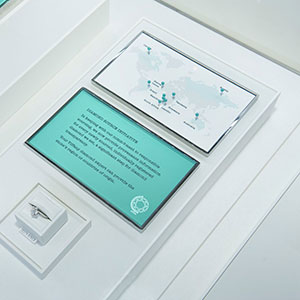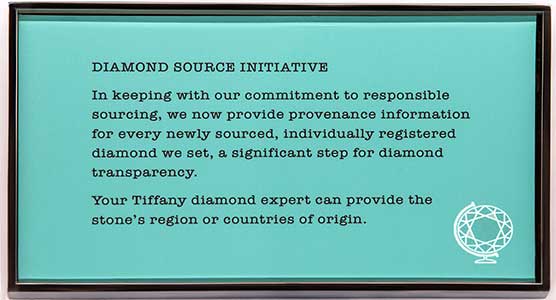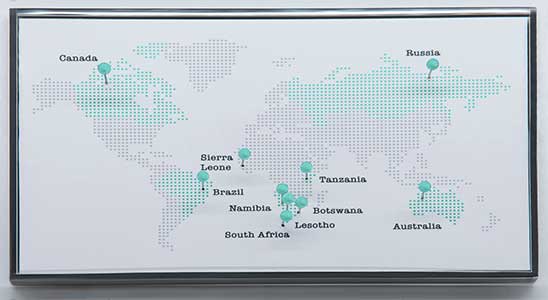
Tiffany & Co. announced today it is now including country-of-origin information on just about all the diamonds it sells over 0.18 cts.
As part of its new Diamond Source Initiative, beginning today, each diamond will get a laser-etched Tiffany & Co. serial number that will include information about each gem’s specific provenance and country of origin. Later this year, that information will be added to the company’s in-house grading reports.
In some cases, that provenance information will also be included on the store display. It also hopes to offer additional information about the specific diamond-producing countries.

As De Beers does not segregate its diamonds by origin, De Beers-mined stones will be marked “Botswana sort.” De Beers only recently reversed its prior policy that forbade downstream participants from identifying diamonds from its mines.
By 2020, Tiffany also hopes to add information on its diamonds’ “craftsmanship journey,” which will include information about where they are cut and polished.
Andy Hart, Tiffany’s senior vice president of diamond and jewelry supply, says that the retailer is able to provide this information because more than 80 percent of its diamonds come from rough that it buys from the source and then manufactures.
The other 20 percent comes from third-party suppliers. “Those are trusted partners we have been working with for long time, and we have been working with them to make sure that their supply chains are transparent,” Hart says.
The only exceptions to the program will be diamonds that Tiffany purchased before this program was conceived, which will be called Tiffany Heritage diamonds.
“We have a very small percentage that are responsibly sourced where we won’t include the origin,” Hart says.
For now, the company is just disclosing the country of origin, not the specific mine, but Hart says that is information that it would eventually like to provide—as well as sourcing information about the precious metals and gemstones it uses.
“We believe in transparency for all the materials,” he says. “Precious metals have been largely under our control, and we have known [their origin] for a long time and I think the same should apply to colored gemstones. We are already making progress and will continue to work on that.”

Hart says luxury consumers increasingly want to know this kind of information.
“In the luxury industry, we are seeing a new generation of buyers that cares about the environment, social responsibility, human rights, and labor practices, and they care about the diamond traceability,” he says. “We believe that [origin] is a crucial piece of information that will allow consumers to make an informed purchase.”
As for lab-grown diamonds, Hart sounded unenthusiastic.
“Our position is lab-grown diamonds are not a luxury material. We don’t see a role for them in a luxury brand. They have their use and they have their place, but I think luxury consumers will continue to desire the rarity and amazing story of natural diamonds.”
(Images from Tiffany & Co.)
Follow JCK on Instagram: @jckmagazineFollow JCK on Twitter: @jckmagazine
Follow JCK on Facebook: @jckmagazine